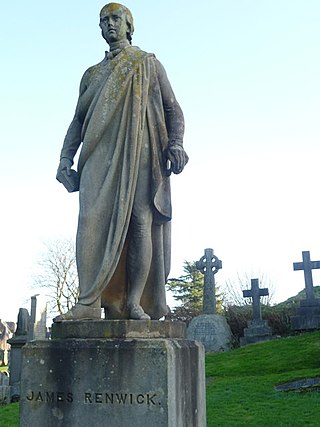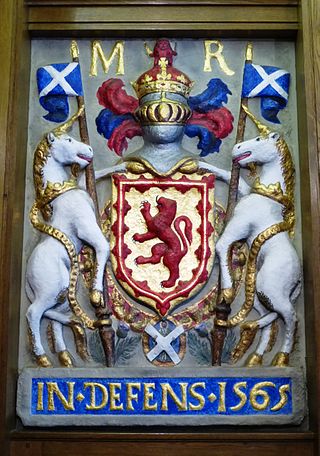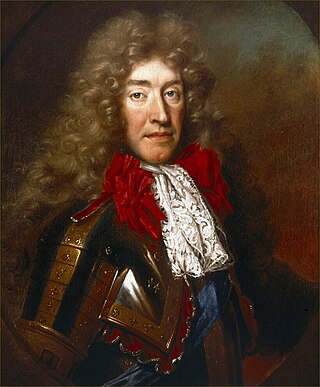Related Research Articles

The Bill of Rights 1689 is an Act of the Parliament of England that set out certain basic civil rights and clarified who would be next to inherit the Crown. It remains a crucial statute in English constitutional law.

The constitution of the United Kingdom is an uncodified constitution made up of various statutes, judicial precedents, convention, treaties and other sources. Beginning in the Middle Ages, the constitution developed gradually in response to various crises. By the 20th century, the British monarchy had become a constitutional and ceremonial monarchy, and Parliament developed into a representative body exercising parliamentary sovereignty.

The Claim of Right is an Act passed by the Convention of the Estates, a sister body to the Parliament of Scotland, in April 1689. It is one of the key documents of United Kingdom constitutional law and Scottish constitutional law.
The Privy Council of Scotland was a body that advised the Scottish monarch. In the range of its functions the council was often more important than the Estates in the running the country. Its registers include a wide range of material on the political, administrative, economic and social affairs of the Kingdom of Scotland. The council supervised the administration of the law, regulated trade and shipping, took emergency measures against the plague, granted licences to travel, administered oaths of allegiance, banished beggars and gypsies, dealt with witches, recusants, Covenanters and Jacobites and tackled the problem of lawlessness in the Highlands and the Borders.

The Parliament of Scotland was the legislature of the Kingdom of Scotland from the 13th century until 1707. The parliament evolved during the early 13th century from the king's council of bishops and earls, with the first identifiable parliament being held in 1235 during the reign of Alexander II, when it already possessed a political and judicial role.

The Killing Time was a period of conflict in Scottish history between the Presbyterian Covenanter movement, based largely in the southwest of the country, and the government forces of Kings Charles II and James VII. The period, roughly from 1679 to the Glorious Revolution of 1688, was subsequently called The Killing Time by Robert Wodrow in his The History of the Sufferings of the Church of Scotland from the Restoration to the Revolution, published in 1721–22. It is an important episode in the martyrology of the Church of Scotland.

The Crown and Parliament Recognition Act 1689 was an Act of the Parliament of England, passed in April 1690 but backdated to the start of the parliamentary session, which started on 20 March 1690. It was designed to confirm the succession to the throne of King William III and Queen Mary II of England and to confirm the validity of the laws passed by the Convention Parliament which had been irregularly convened following the Glorious Revolution and the end of James II's reign.
General Council in medieval Scotland was a sister institution to parliament that existed between the late fourteenth century and the early sixteenth century. It has been argued to be almost indistinguishable from parliament, and has always been treated together with parliament by historians. The main difference was that it could be called with less than the statutory 40 days' notice required for parliament and other courts, and, since it was not a court, did not have the final judicial capacity of the senior institution over issues such as forfeiture of life and property for treason. It could and did raise taxation and issued legislation just as important as parliament. In times of royal minority or incapacity, it was often preferred to parliament (for instance the reigns of Robert II, Robert III, the period of captivity of James I, and much of the long minority of James II. In the reign of James III, it seems to have been largely abandoned, even in the minority period of 1466 to 1470 although this may be partly a side effect of its records being separated from the main register of parliament, and subsequently lost. General Councils finally ceased to be held at all in the reign of James IV, shortly before Conventions of Estates began to be held.

The 1689 Convention of Estates sat between 16 March 1689 and 5 June 1689 to determine the settlement of the Scottish throne, following the deposition of James VII in the 1688 Glorious Revolution. The Convention of the Estates of Scotland was a sister-institution to Parliament, comprising the three estates of bishops, barons and representatives of the Burghs. Historically, it had been summoned by the king of Scots for the limited purpose of raising taxes, and could not pass other legislation. Unlike the English Convention Parliament of 1689, the 1689 Scottish Convention was also a contest for control of the Church of Scotland or Kirk.

Scotland in the early modern period refers, for the purposes of this article, to Scotland between the death of James IV in 1513 and the end of the Jacobite risings in the mid-eighteenth century. It roughly corresponds to the early modern period in Europe, beginning with the Renaissance and Reformation and ending with the start of the Enlightenment and Industrial Revolution.

The constitution of the United Kingdom comprises the written and unwritten arrangements that establish the United Kingdom of Great Britain and Northern Ireland as a political body. Unlike in most countries, no official attempt has been made to codify such arrangements into a single document, thus it is known as an uncodified constitution. This enables the constitution to be easily changed as no provisions are formally entrenched.

The Restoration was the return of the monarchy to Scotland in 1660 after the period of the Commonwealth, and the subsequent three decades of Scottish history until the Revolution and Convention of Estates of 1689. It was part of a wider Restoration in the British Isles that included the return of the Stuart dynasty to the thrones of England and Ireland in the person of Charles II.

The English Convention was an assembly of the Parliament of England which met between 22 January and 12 February 1689 and transferred the crowns of England and Ireland from James II to William III and Mary II.

Government in medieval Scotland, includes all forms of politics and administration of the minor kingdoms that emerged after the departure of the Romans from central and southern Britain in the fifth century, through the development and growth of the combined Scottish and Pictish kingdom of Alba into the kingdom of Scotland, until the adoption of the reforms of the Renaissance in the fifteenth century.

Government in early modern Scotland included all forms of administration, from the crown, through national institutions, to systems of local government and the law, between the early sixteenth century and the mid-eighteenth century. It roughly corresponds to the early modern era in Europe, beginning with the Renaissance and Reformation and ending with the last Jacobite risings and the beginnings of the industrial revolution. Monarchs of this period were the Stuarts: James IV, James V, Mary Queen of Scots, James VI, Charles I, Charles II, James VII, William III and Mary II, Anne, and the Hanoverians: George I and George II.

The Glorious Revolution in Scotland refers to the Scottish element of the 1688 Glorious Revolution, in which James VII was replaced by his daughter Mary II and her husband William III as joint monarchs of Scotland and England. Prior to 1707, the two kingdoms shared a common monarch but were separate legal entities, so decisions in one did not bind the other. In both countries, the Revolution confirmed the primacy of Parliament over the Crown, while the Church of Scotland was re-established as a Presbyterian rather than Episcopalian polity.
The Convention of Royal Burghs, more fully termed the Convention of the Royal Burghs of Scotland, was a representative assembly which protected the privileges and pursued the interests of Scotland’s principal trading towns, the royal burghs, from the middle of the 16th century to the second half of the 20th century. It evolved as a forum in which burgh delegates, termed "commissioners", could "consult together and take common action in matters concerning their common welfare" before and during the sittings of parliament. An exclusively merchant body, it was essentially a parliament which "declared the law of the burghs" just as the Scottish Parliament "declared the law of the land". The Convention expanded over time by admitting lesser burghs to its membership; and by the 16th century had grown in influence to the extent that "it was listened to rather than directed by the government". Though still known as the "convention of royal burghs", it referred to itself from the late 17th century onwards as simply the "convention of burghs", as by then membership was no longer restricted exclusively to royal burghs and commissioners from all types of burgh were represented in parliament.
Events from 1689 in the Kingdom of Scotland
Culross in Perthshire was a royal burgh that returned one commissioner to the Parliament of Scotland and to the Convention of Estates.
Before the Act of Union 1707, the barons of the sheriffdom or shire of Dumfries and the stewartry of Annandale elected commissioners to represent them in the unicameral Parliament of Scotland and in the Convention of Estates. The number of commissioners was increased from two to four in 1690.
References
- ↑ Colin Kidd (2003). Subverting Scotland's Past: Scottish Whig Historians and the Creation of an Anglo-British Identity 1689-1830. Cambridge University Press. pp. 132–133. ISBN 978-0-521-52019-5.